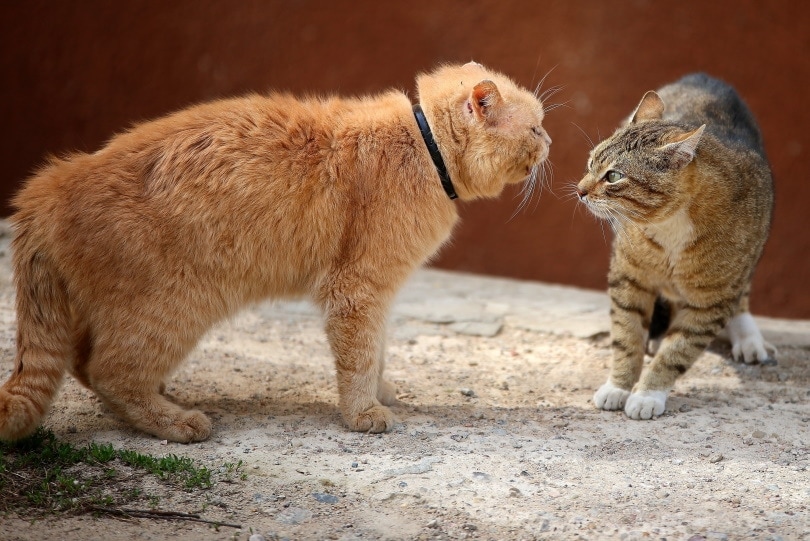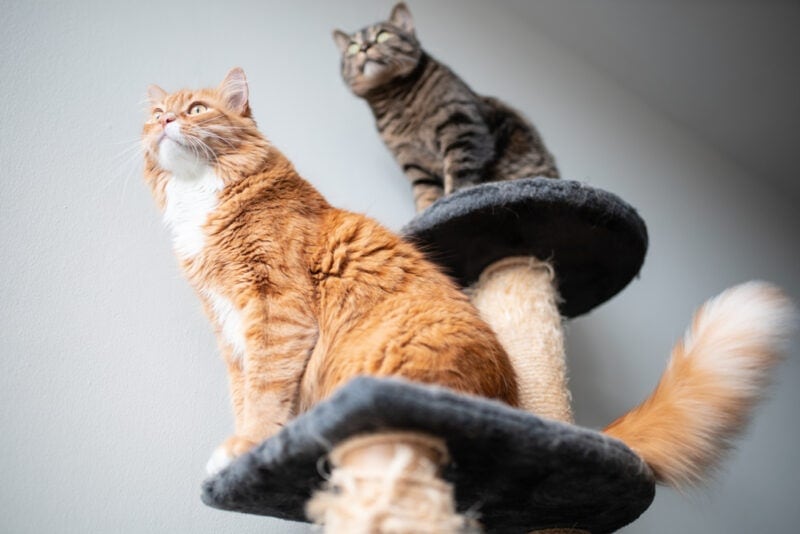
Introducing two male cats may sound challenging, but it’s not. Contrary to popular belief, male cats are likely to get along better than females. The trick to ensuring the two don’t “fight to the death” over territory issues is introducing them after they are neutered. You’ll also need to provide separate resources like food bowls, beds, and litter boxes to reduce competition.
Two cats are always better than one, and your pet will love the companionship of one of its own species. However, it takes a proper introduction to reduce the risk of the pair getting into constant fights or spraying urine on every corner of your home.
Are you curious how to ensure the “boys” get along right from the onset? Here are nine expert tips to give you a leg up when introducing your two male cats.
The 9 Tips How to Introduce Two Male Cats
1. Create Separate Base Camps
The first step to introducing male cats is the isolation phase. Let your current pet have its favorite spot in the house and create another for the newcomer. Essentially, you want both pets to have an area they can call their own.
If your resident pet loves spending time in the living room, you could put the newcomer in the spare room or home office. Any space with your scent will suffice, provided you can prevent the two pets from meeting.
When creating separate base camps, ensure each has almost identical resources to reduce competition. This includes a scratching post/board, bed, and bedding. Your new cat will also need its own food bowls and litter box.

2. Let the New Cat Feel at Home
Once your new male cat arrives, give it a few days to get used to the new environment. Ensure it does not meet the resident pet just yet because this can create unnecessary tension.
After at least three days, you can move to the next introduction phase.
3. Swap Scents
Cats rely heavily on scents to communicate and gather information. Once your new feline friend adjusts to its new surroundings, you can introduce it to the smell of the resident cat.
Pet the resident cat for a few minutes and stroke the new feline with the same hand before you wash it and vice versa. Ensure you target the scent glands around the chin, cheeks, whiskers, and at the base of the ears. The idea is to transfer as much scent as possible and ensure the pets know of each other’s existence even without meeting.
Also, swap bedding and allow the pets to investigate and explore each other’s base camps. Remember that your attempts to have amicable introductions may fail miserably if the two meet too soon and get into a chase or fight.

4. Let the New Cat Explore Your Home
The next step is to let the newcomer get well-acquainted with the rest of your home. Take it out of its base camp and lock it in a room where you can shut the door. Let the resident cat enter the new pet’s sleeping quarters and shut the door. Again, don’t let the two lay eyes on each other.
Now that the resident cat is locked away, the new cat can investigate other parts of your home. Don’t rush this phase, especially if the pet seems too shy to move around. Let it take its time, even if it means exploring your home for a few hours or several days. You could even allow it to nap on the resident cat’s bed.
5. Maintain Predictable Feeding Routines
In multiple pet households, feeding time can be hectic1, although it doesn’t have to be. Food can also make bonding time special as the pets engage in an activity they love. The secret to ensuring they develop a positive association with mealtime is to create a predictable feeding routine.
Instead of free feeding your cats and providing a constant source of food, feed them at specific times of the day and empty the food bowls after half an hour. Get the newcomer well acquainted with your feeding routine, and don’t make any compromises.

6. Let the Cats See Each Other
During the visual introduction, ensure the cats don’t meet physically. Use pet gates to create a buffer barrier and limit visual access using a drape or blanket. Hang it over the pet gate to ensure the pets have to peep to see each other.
Increase the visual access over the next few days before ditching the drape/blanket altogether. Reward the boys for desired behavior and pet them or toss treats to encourage amicable interactions.
7. Schedule a Non-Physical Food & Play Date
Now that your cats have a predictable feeding routine, it’s time to let them meet during feeding time. Ensure each cat has its food and water bowl and feed them from spots where they can see each other. Move the bowls closer during each feeding date without allowing any physical contact.
Food dates allow the cats to develop a positive association with their visual interactions. On the other hand, the predictable feeding routine will ensure the pets know they don’t need to compete for valuable resources.
After the meal, let the cats rest before engaging them in play. Give each feline equal attention again and use treats to reward desirable behavior.

8. It’s Time for a One-On-One Meeting!
Your cats should, at this point, be comfortable with each other’s presence. If not, continue with the non-physical food and play dates until both can stand being in the same room without keeping their hair raised.
The first one one-on-one meeting can quickly go south, so it is advisable to seek the help of a friend. Keep the pets separated by a barrier and play with one of the cats as your pal plays with the other. It would help if you used interactive toys to make the pets as engrossed in the game as possible. Remove the barrier after 10 minutes and continue the play session for another 20 minutes.
During the session, keep a close eye on how the pair interacts and intervene by clapping if you see any signs of aggression.
Gradually prolong the duration of food and play dates until the cats can spend several hours each day together.
9. Carefully Monitor Interactions for the Next Couple of Months
You must monitor interactions between your pets for the next couple of months. Routinely keep them separate so they can take a break from each other. It is also crucial not to leave them together when you are away from home.
If all goes well, the bond between the pair will grow stronger each day. Unfortunately, they might get into altercations from time to time. When this happens, separate the two for several days to let them cool off. Reintroduce them again during a play date.
The road to ensuring your pets have a positive relationship and develop mutual respect requires plenty of patience. It may take several months before you can confidently leave them together for a whole day without supervision.

FAQs
Will My Two Male Cats Form a Strong Bond?
Whether two male cats can form a strong bond depends on their temperaments. If their personalities line up, they are likely to start cuddling and getting cozy around one another in no time. Felines with calm and laid-back personalities often form strong bonds and enjoy beautiful friendships. Two territorial males can, on the other hand, will drive each other up the wall.\
Do Neutered Male Cats Fight Over Territories?
Neutered males are calmer because they don’t battle over territory issues to enhance their chances of attracting females during mating season. However, this does not guarantee they will not fight to defend their turf. Some retain their instinctual territorial behaviors, making it best to reduce competition whenever possible. For instance, provide separate food bowls, beds, base camps, and litter boxes.

How Long Will It Take for My Two Male Cats to Get Along?
Male cats can take one to six months to tolerate each other. However, building a friendship can take up to 12 months. Also, some pairs never get along and learn to stay off each other’s hair. Only a tiny percentage get overly resistant to companionship, and one must be re-homed eventually.
See Also: Can Two Male Cats Get Along In The Same House?
Final Thoughts
Despite their seemingly independent natures, cats love the companionship of humans and other felines. Neutered boys grow into inseparable playmates faster if you handle the introduction phase like a pro. Even intact males can tolerate each other, provided you minimize competition. Merely seeing one another roaming the other corner of the home can help break the monotony and alleviate loneliness.
So, should you take a leap of faith and introduce your current male cat to another male cat?
It depends. If you want to introduce a pair, ensure you have the time and patience to oversee a proper introduction. Your efforts may delight you with the sight of your rambunctious boys enjoying hours of hearty play!
Featured Image Credit: Vshivkova, Shutterstock







